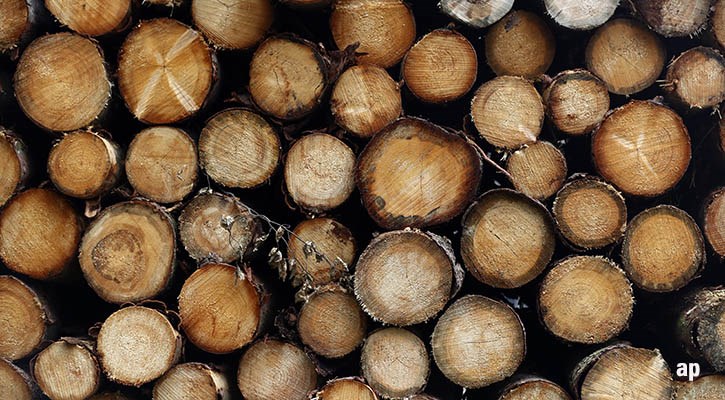
Wood has become the latest social media obsession, spawning countless Twitter memes and TikTok videos. With lumber (or timber if you’re a Brit) prices hitting record highs in recent months, this niche asset class has been thrown into the spotlight amid supply shortages and booming demand for materials to build houses.
As part of our thematic week, we look at the outlook for global timber and forestry, whether chopping down trees (and re-planting them) can be considered sustainable, and what options are available for investors.
Before you head to the garden centre and start stockpiling fence panels, it’s worth taking a look at how the market works. Those fence panels are known as harvested wood products (HWP) which are used by consumers and the building trade. These can take the form of firewood and materials to build houses, but also be made into printer paper and cardboard boxes, both in high demand during the pandemic.
But timber is also a traded financial product, classified as a soft commodity in a wider basket including soya beans, corn and wheat – all of which have been booming this year. Companies that produce it are listed on the stock market (see below), while lumber is tradeable on the Nasdaq as a commodity (ticker LBS), and forms part of a number of indices – such as the FTSE All World Developed Europe Forestry index. ETFs focused on food materials like these were among the best performers in April 2021, according to Morningstar data. Like other “hard” commodities like precious metals, timber prices are set by supply and demand, the product has a life cycle - and making it produces carbon emissions.
Build, Renovate and Repair
Lumber prices have generally traded within a range of $200-$400 per board feet in the last 20 years but spiked above $1,600 this year amid strong demand for the US housing market.
The coronavirus pandemic has forced structural change on this market but because of lockdown disruption, production has struggled to keep up. American home owners now want larger houses and are looking at areas outside of big cities, says Mikael Jafs, senior investment manager at the Pictet Timber Fund.
A swift economic rebound from the pandemic in the US has helped, where 1.5 million homes are being built a year after a slump in 2020. As well as new houses, DIY and even self-build projects have made lumber even scarcer, say economists at Wells Fargo: “The pandemic spurred demand for more useful living space to accommodate working from home and remote learning. This abrupt shift in demand fuelled a surge in renovation and repair spending and set off a wave of home buying during the second half of last year.”
Chopping Down Trees, Planting More
ESG investors may struggle with the concept that forestry and timber can be sustainable investments – after all, deforestation is a big challenge for preserving habitats and slowing climate change. Illegal logging in countries like Brazil and Indonesia also conjure up negative images of the industry.
Pictet’s Gillian Diesen says investors need to understand that the listed timber companies are using forests for commercial use and not chopping through wilderness. She defines this as “timberland”, which is “sustainably managed forest in highly regulated jurisdictions that protect and uphold the integrity of the forest”. The mantra of operators in this space is to “cut one, replace three”, she says. Bodies like the Forest Stewardship Council (FSC) enforce higher standards for sustainable forestry and replanted trees can absorb carbon, helping to slow the effects of climate change. Carbon remains locked into timber even if it is used to build a house (burning it does release carbon though). Trees can also be can also made into "biomaterial" products like tyres and drinking bottles, says Pictet's Jafs, although we're a long way off from replacing plastics completely.
Investor Options - Stocks or Funds
One indirect access point for forestry investors is to buy listed lumber/timber companies, which are generally based in North America. One of the largest firms, $16 billion West Fraser Timber (WFG) is the largest holding in iShares Global Timber & Forestry ETF (WOOD), which has 25 equity holdings. The ETF has a Morningstar Sustainability Rating of 5 Globes, the highest possible ranking, and has returned 13% in the year to date and nearly 17% on an annualised basis over five years.
What if an investor wants more direct access to the industry? Buying forests is out of the reach of most retail investors, so one option is via an active fund, which does have direct ownership of these assets. Anthony Crosbie Dawson, director of forestry and private clients at Gresham House, explains that an investor in a timber fund in effect becomes a fractional owner of forests - but with the benefits of owning a more liquid and diversified asset.
Gresham House is launching a new UK fund at the end of May which will invest in both unplanted land and established forests, as well as generating returns from the sale of timber and carbon credits. The fund can also benefit from the capital appreciation of the land and trees.
Like many thematic plays, it’s clear that forestry should only make up a small percentage of a diversfied portfolio. Lumber prices are currently high and have been historically volatile, but fund managers in the space are long term investors. "Although the price of timber can be volatile, as with all commodities, the forests themselves are valued on a long term basis, so any short term timber price volatility does not impact forest values," says Gresham House's Crosbie Dawson.
Beware Scammers Hiding in the Woods
New investors should be on their guard, though, against forestry investment scams – victims are often cold-called and persuaded to invest in forests in far-flung places like Costa Rica. As the FCA explains, beware of unsolicited approaches, seek independent financial advice before taking the plunge and make sure that any investments are made in regulated products like those mentioned above. Booming investment areas like timber and crypto attract scammers who take advantage of investors' "fear of missing out" and desire to make a quick return, the regulator warns on its "ScamSmart" website.


























